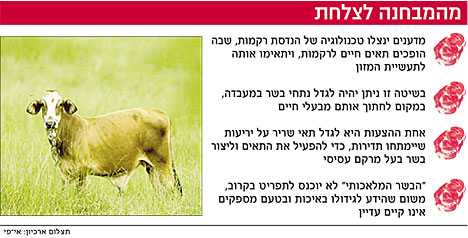Ian Sample, Guardian, Walla News

A dilemma for vegetarians?
This will be the ultimate problem of the vegetarians, who believe that meat is the result of killing animals. The revolution in processed food production may bring to our plates meat grown from animal cells without a single cow, lamb or pig being slaughtered for it. An article recently published in a journal dealing with biotechnology described a new method, which researchers define as a solution to the world's food shortage. It will be possible to grow pieces of meat in the laboratory, instead of cutting them from farm-raised animals.
According to the article, scientists have taken advantage of the advanced technology of tissue engineering, where individual cells are duplicated into whole tissues, to suit the food industry. "Theoretically, one cell could supply the world's meat consumption," said Jason Matheny, an agricultural scientist at the University of Maryland.
According to the researchers, meat grown in laboratories will be more environmentally friendly, and it will be possible to produce it in a way that will be healthier than natural meat, while monitoring its nutritional components and auditing to prevent the development of food-borne diseases.
Vegetarians may also be tempted to eat such meat, since the cells required to grow it will be taken from the "donors" without causing them suffering. Experiments conducted for the American Space Agency (NASA) showed that it is possible to grow edible fish pieces in laboratory flasks, although so far no one has tasted them.
At the same time, Matheny and his colleagues advance the idea of "artificial meat" one step further, with the aim of producing it on an industrial scale. In their vision, they see muscle cells growing on giant sheets that will be stretched frequently, to activate the cells during growth. When the number of cells is sufficient, they will be "peeled" from the sheets and processed into different shapes, such as chicken pieces. "If we don't simply stretch them, we'll eat porridge", Mathani explained.
The idea of growing meat not in the traditional way, but from the ground up - from a single cell - was first raised about 70 years ago. Winston Churchill wrote in 1932, that "in 50 years we will not raise a whole chicken just to eat the breast or the wing. We will expand these parts separately." Today it seems that Churchill's vision is becoming a reality.
However, lab-grown steaks will not be on our menu in the near future. According to scientists, the science of tissue engineering is advanced enough to produce homogeneous meat that lacks a unique taste, but the method for growing juicy pieces of meat with a special texture has not yet been found. "Currently, it is possible to produce something similar to canned meat at a very high cost, but the knowledge required to grow something with a complex structure like a steak is still far from us," Matheny said.
Kerry Bennett from the British Vegetarian Association said in response, "This is undoubtedly an interesting development that will evoke different reactions from vegetarians, depending on the reason why they chose to be vegetarian in the first place. The vegetarian association fears that, despite the possibility that the development will reduce the number of animals in the industrial breeding farms, there are still question marks regarding the source of the cells and the way in which they will be taken from the donor animals. It will not suit a person who has given up eating meat because he thinks it is immoral, or someone who does not want to eat unnatural things." She added that "personally it's not magic for me, but I assume that if they produce chicken pieces, there won't be a significant difference in taste."
https://www.hayadan.org.il/BuildaGate4/general2/data_card.php?Cat=~~~243975996~~~27&SiteName=hayadan
